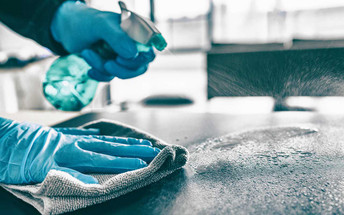Disinfecting Clear Plastic
How do you disinfect a clear plastic sheet?
Understandably, this has been a common question over the past several months as businesses and consumers seek to enhance the cleanliness of their facility, home and/or products. Clear plastic barriers are commonplace in retail stores, restaurants, offices and public building. But what’s the best method of clean those barriers without damaging them?
The simple answer is warm water, dish soap and a microfiber cloth. This is a simple, effective and gentle way to clean and disinfect an acrylic, polycarbonate or PETG sheet. Just like your hands, soap is an effective product to remove germs on a surface. The use of a microfiber cloth not only helps to remove germs, but will not damage (scratch) the surface of the material. In general, polycarbonate is more susceptible to scratching than acrylic, so take proper cleaning steps when cleaning polycarbonate in order to extend the product’s life.
Some streaking may appear on the clear plastic sheet after being cleaned with soap and water, reducing the overall clarify of the sheet. In these cases, a secondary plastic cleaner, such as NOVUS or Brillanize, can be used to remove water spots or streaks. These cleaners do just that, clean. They do not disinfect. Avoid using household glass cleaners that contain ammonia on plastic, as ammonia will damage the material over time. Crazing occurs when the plastic material becomes stiffer and more brittle. Certain chemicals, like ammonia, can cause tiny cracks or micro fractures (crazing) to develop, typically starting at the edges.
Using other aggressive chemicals, such as bleach or hydrogen peroxide, brings in the risk of damaging the material as well. However, diluting the bleach with water (approximately 1/3 cup of bleach for every gallon of water) and limiting the exposure time on the material will help protect the clear plastic sheets from damage. Certain chemicals high in Ph, such as chlorine-based bleach, can damage microfiber cloths. Microfiber cloths do not kill bacteria on a surface, rather it removes it.
Clear plastic, such as face shields, that are used in medical facilities should not be heat sterilized.
EPA APPROVED PRODUCTS IN THE FIGHT AGAINST COVID-19

